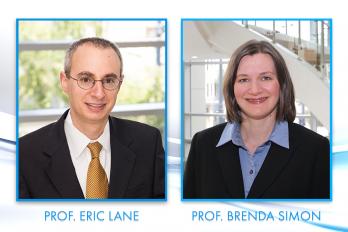Thomas Jefferson School of Law Professors Brenda Simon and Eric Lane were presenters at the 13th Annual Intellectual Property Scholars Conference (IPSC) at Benjamin N. Cardozo School of Law on August 8-9.
According to the IPSC, “The IP Scholars Conference brings together intellectual property scholars to present their works-in-progress in order to benefit from the critique of colleagues. The conference is co-sponsored by the Berkeley Center for Law and Technology, UC Berkeley School of Law; the Intellectual Property Law Program, Benjamin N. Cardozo School of Law at Yeshiva University; the Center for Intellectual Property Law and Information Technology, DePaul University College of Law; and the Stanford Program in Law, Science & Technology, Stanford Law School”
Professor Simon spoke about a way to clarify one of the most convoluted and subjective tests of patent law, the analogous arts test. Essentially, she proposed grounding the obviousness analysis in what is actually going on the field to help in the determination.
Professor Lane spoke about an empirical study and content analysis of patent-focused press releases generated by patent holders. The study offers a taxonomy of patent PR content and calculates the relative proportions of the various subject matter categories.
Below are abstracts of both Professor Simon and Professor Lane’s presentations: Restructuring the Obviousness Analysis Brenda M. Simon The great question of patent law, obviousness, is a muddle. Attempts to clarify the doctrine face a significant obstacle: the constraints of prosecution are different from those of litigation. The goal of providing efficient and cost-effective prosecution limits the amount of time examiners can spend determining obviousness. As a result, examiners have used the analogous arts test as a rough gauge of obviousness during prosecution. The Federal Circuit has not, however, provided much guidance on how to apply the analogous arts test, resulting in an unpredictable doctrine.
While this uncertainty may be tolerable during prosecution, where time-pressed examiners are forgiven for relying on common sense among other things, courts should be held to higher standards. In particular, courts should no longer be permitted to rely on the subjective and outdated analogous arts test as a shortcut to find inventions obvious. During litigation, more time and resources can be spent on the obviousness assessment. At that time, decision-makers should ascertain common practices in the field of invention and whether the invention is obvious in light of them. This restructuring of the obviousness analysis during litigation should result in a more accurate determination of obviousness when it matters most.
Patent PR Eric L. Lane As debates about the patent system have spread beyond the legal community into the public square, there has been an increase in mainstream media coverage of patent issues, including PR content generated by patent holders. However, we know very little about the subject matter of this media content and even less about its potential effects on public opinion and patent policy. This study begins to fill these gaps by building and analyzing a data set of patent-focused press releases generated by patent holders, or their licensees, and cataloging the subject matter contained therein. It offers a taxonomy of patent-focused PR content and calculates the relative proportions of patent PR relating to the top-level categories of Prosecution; Litigation; Transaction; Post-Grant Procedure; Honors/Accolades; Patented or Patent-Pending Product; ANDA Patent Challenge; and Miscellaneous.
Within the top-level categories, this study calculates the relative proportion of second-level subject matter categories. In the Prosecution category, for example, this study calculates the proportion of press releases involving the categories of Patent Granted; Notice of Allowance; Application Filed; Application Pending; Application Accelerated; Response to Office Action Filed; Application Withdrawn from Issue; and Interference Declared. The Litigation category includes, inter alia, the categories of Settlement; Lawsuit Filed; Court Order or Ruling; Verdict; Comment; and Appealed. The study also analyzes patent PR by industry to determine which industries or technology fields generate the most patent-focused PR content and which subject matter areas are favored by particular industries. The data presented in this study enable us to determine which patent matters technology firms believe are important to highlight and provide a baseline for subsequent inquiries into how patent PR may affect policy and public opinion of patents and patentees.

